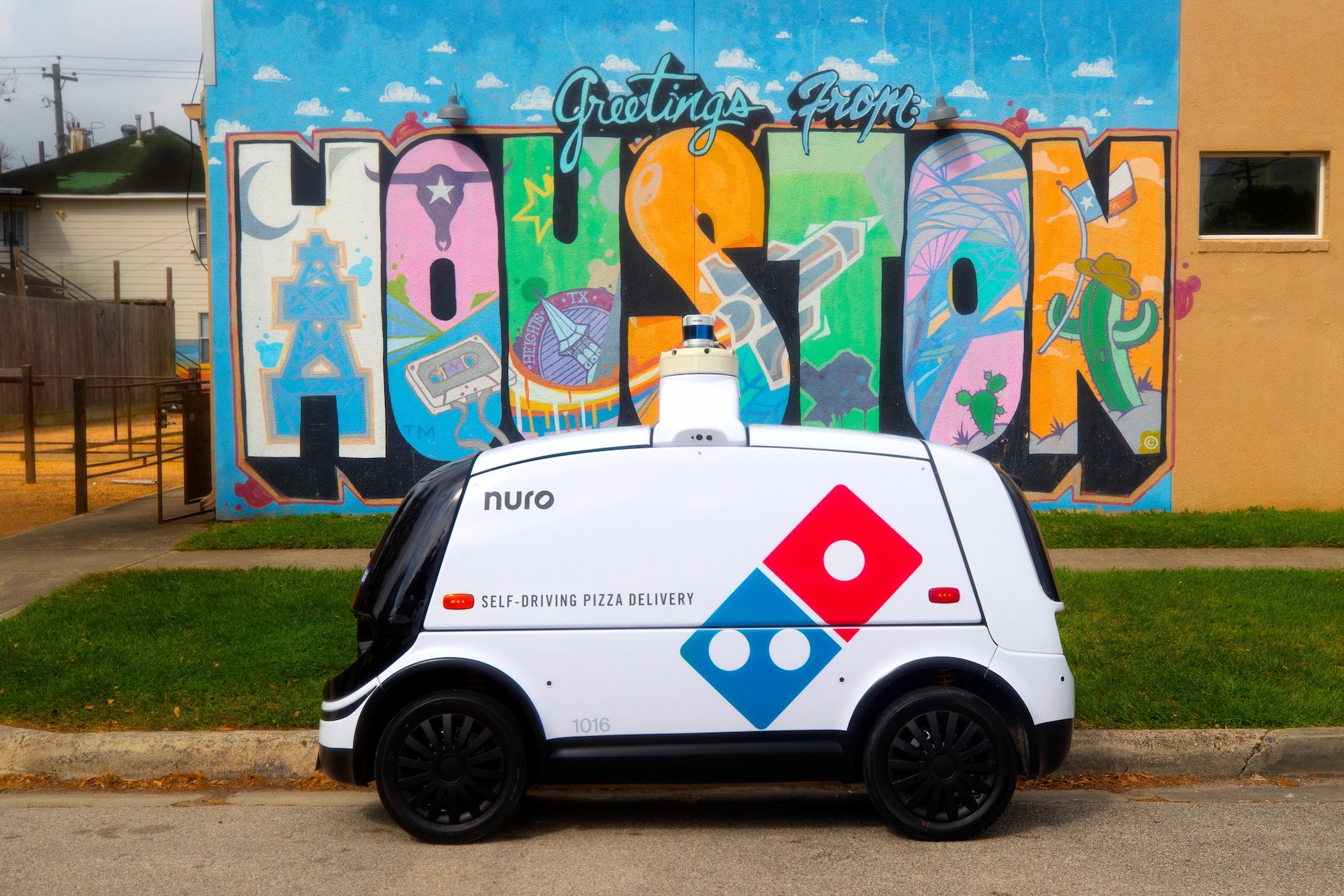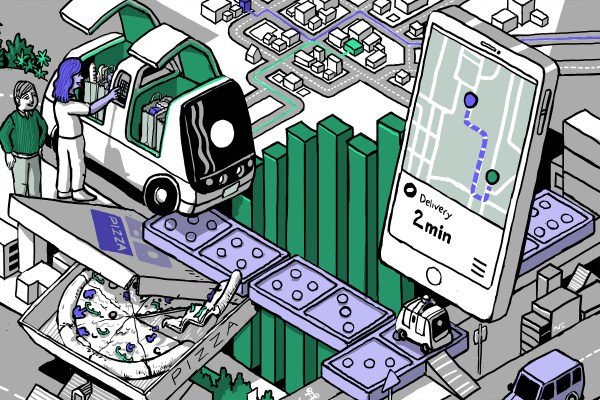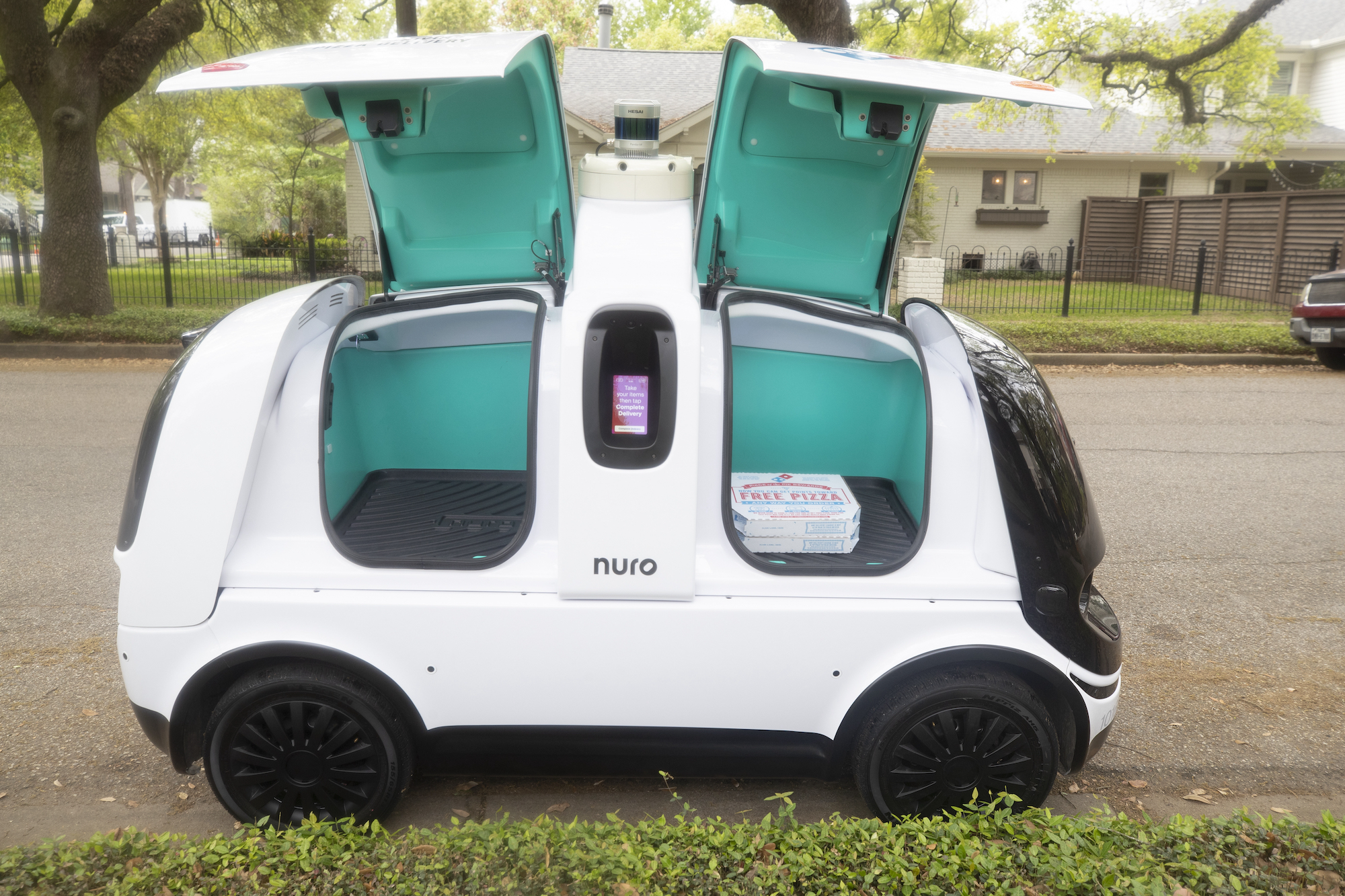Pandemic pizza was definitely a thing.
U.S. consumers forked out a record-breaking $14 billion to have pizza delivered to their doors in 2020, and nearly half of that total was spent with just one brand: Domino’s.
“Domino’s is the home of pizza delivery,” said Dennis Maloney, Domino’s chief innovation officer. “Delivery is at the core of who we are, so it’s very important for us to lead when it comes to the consumer experience of delivery.”
U.S. consumers forked out a record-breaking $14 billion to have pizza delivered to their doors in 2020, and nearly half of that total was spent with just one brand: Domino’s.
In its latest TV ad, an order of Domino’s pizza speeds to its destination inside a Nuro R2 delivery autonomous vehicle (AV). The R2 deftly avoids potholes, falling trees and traffic jams caused by The Noid — a character created by Domino’s in the 1980s to symbolize the difficulties of delivering a pizza in 30 minutes or less.
The reality is much more sedate. Domino’s currently has just one R2 that operates from a single Domino’s store on the generally calm streets of Woodland Heights in Houston, Texas. And since the AV’s introduction in April, The Noid has yet to put in an appearance.
“The R2 adds a bunch of efficiencies while not taking away from any existing capabilities,” Maloney said. “As we start getting the bot into regular operation, we’ll see if it plays out the way we expect it to. So far, all the indications are good.”

Nuro and Domnio’s launched the autonomous pizza delivery service in Houston in April this year. Image Credits: Nuro
Partnerships are key for Nuro. The company’s business model is to sign contracts with established brands that either have their own branded vehicles or use traditional delivery companies like UPS or the U.S. Postal Service.
Nuro is carrying out trials and pilot deliveries with a number of companies, including fast casual restaurant chain Chipotle, Kroger grocery stores, CVS pharmacies, bricks-and-mortar retail behemoth Walmart, and, most recently, global parcel courier FedEx. While it is a dizzyingly impressive list for a company less than five years old, their interest was driven as much by global trends as by Nuro’s technology, admits Cosimo Leipold, head of partnerships at Nuro.
“Everybody today wants what they want and they want it faster than ever, but frankly they’re not willing to pay for it,” Leipold said. “We’ve reached a point where almost every company is going to have to offer delivery services, and now it’s just the question of how they’ll do it in the best possible way and with the most possible control.”
Nuro’s delivery AVs — aka bots — offer the tantalizing promise of safe, reliable and efficient delivery without sacrificing revenue and customer data to third-party platforms like Grubhub, DoorDash or Instacart. Alongside Nuro’s stated aim of driving the cost of delivery down to zero, it is little surprise that Nuro now finds itself in the enviable position of being able to pick and choose the partners it wants — and the less enviable position of having to choose which partner to prioritize.
Here’s the story of how one of Nuro’s biggest partnerships came to be, and the lessons and companies that will drive its future growth.
Deliveries with extra cheese
Domino’s has a long history of innovating in delivery, usually accompanied by a strong marketing campaign. In the 1980s, the company bought 10 customized Tritan Aerocar 2s, a Jetsons-styled three-wheeler, for use as delivery vehicles. In 2015, the company unveiled the DXP, a Chevrolet Spark modified with a single seat and a built-in warming oven, designed specifically for transporting pizza.
Two years later, Domino’s collaborated with Ford Motors to explore how autonomous vehicles might transform its business. That effort, in Ann Arbor, Michigan involved a small fleet of Ford Fusion Hybrid autonomous research vehicles, manually driven by safety drivers.
“There was a massive amount of base learning to understand as we started thinking how AVs could impact business models, consumer experiences and all the potential places this could work or could not work,” Maloney said.
While the program was popular — particularly when the car incidentally delivered pizza to excited researchers at the University of Michigan’s robotics lab — Domino’s quickly realized that the retrofitted AV didn’t suit its operations.
“Using a two-ton, people-moving vehicle to move two pizzas weighing less than four pounds makes no sense whatsoever,” Maloney said. “It became really clear to us that the biggest opportunity for us was not a vehicle that had been optimized for moving passengers, but one purpose-built for moving goods.”
A chance encounter at a conference in 2019 led to a meeting where Nuro pitched Domino’s on its zero-occupancy bots. The timing was perfect, as Nuro came to the table with months of experience from its first commercial partner, Kroger.
Nuro had not even finalized its R1 prototype vehicle when it entered talks with Kroger in 2017, Leipold recalled. “We wanted to learn from partners what they needed as quickly as we could. We started with grocery because it tests the compartment design, and because we felt it was such a nascent and untapped opportunity.”
At that point, e-commerce made up around just 2% of total food and beverage sales in the United States.
Paper, plastic or bot?
Grocery required a vehicle that could handle thousands of products that differ widely in shape, size, weight and fragility. “If we didn’t build the right compartments at the start, that’s a very expensive thing to change three years down the line,” Leipold said. “To say it could have been a $100 million mistake is probably being generous on the low end.”
Nuro started delivering for Kroger in Scottsdale, Arizona in 2018, but the process was not entirely smooth. An early bottleneck was turning online orders into lists that grocery clerks could use to fill the vehicles.
“Kroger was excited, but couldn’t take on the full lift of integrating completely on day one,” Leipold remarked. “They asked if we had a solution that’s more lightweight. We didn’t, so we built one.”
That solution — a simple dispatch app for a tablet — reassured Kroger and unlocked IT resources within the retail giant to develop a more scalable product. “In the early days, it was all about minimizing thrash for partners, making it easy for them to say yes by showing up with a relatively straightforward turnkey solution,” he said. “Today, it’s much more about being a strategic thought partner.”
For Domino’s deal, that meant encouraging the pizza chain to integrate Nuro into their end-to-end point-of-sale system from the outset. “We’ve realized that if we mess up the front end of this at the store, we run the risk of losing all of the benefits and cost savings because we created friction upstream,” said Leipold.
Tricks with no tips
The shift to delivering hot food was make-or-break for Nuro’s efficiency claims. While consumers are happy with groceries showing up in a broad window, five or 10 minutes’ delay can make the difference between a tasty pizza and a congealed horror.
How would the R2’s top speed of just 25 mph and Nuro’s plan to take longer, safer routes sync with Domino’s aim of getting hot pizzas to customers in a flash?
“It feels like that would be a big conflict, and shockingly, it’s not,” Maloney said. “The biggest thing that makes a difference to whether food gets to you fast is whether you can string together the logistics in real time.”
That means the food needs to start being prepared as soon as the order arrives, get loaded in the vehicle as soon as it’s ready, and then head straight to the customer. “Going 25 mph for 15 seconds as opposed to going 50 mph for 10 seconds doesn’t make a bit of difference when you look at the whole process,” Maloney said. “We can easily do a really large number of our deliveries and meet every criteria we need with Nuro’s robot.”
Another potential worry — that people would be unwilling to come out to the curb to pick up their food from the vehicle — also proved unfounded. And it was all down to not having to tip.
“We had assumed that the act of tipping was a reimbursement to the driver for having driven from point A to point B,” Leipold said. “But what we learned was that consumers associate tipping with the driver bringing stuff the last few feet to your door. They’re okay stepping outside if they don’t have to tip.”
In fact, some customers actually preferred dealing with the R2. “The surprising thing was the degree to which people considered not interacting with the human a positive,” Leipold remarked.
Some had always been uncomfortable about opening their door to a stranger at night, while others no longer had to feel embarrassed about being seen wearing flip-flops or nightwear.
As popular as the R2 is, Domino’s has no plans to scrap its existing delivery network of cars, bikes and e-bikes. “There are always going to be customers who need an actual person to walk the pizza up to their door, and Domino’s will always offer that service,” Maloney said. “As of right now, we think Nuro will play a part in that grouping but not replace the entire group.”
Sharing the pie
Even if Domino’s wanted to move to an all-robot delivery fleet, Nuro is far from ready to enable that. The R2 cannot currently cope with snow or other extreme weather, and is still some ways from mass production.
Nuro is also busy with other partners, each of whom gets a bespoke product. “We literally start with a blank sheet of paper with each partner,” Leipold said. “Unfortunately, that means a lot of work, but the reason we do it is, we ask: What would really change your business or accelerate your future vision?”
Partnering with Walmart or FedEx is not for the faint of heart, John Lilly, venture partner at Greylock Capital and a Nuro board member, noted in a recent interview. “You have to be willing to take feedback and to come in with first principles. Say, ‘Here’s the tool we have, but what’s the world that you guys need?’ Then think about how to make it happen together,” he said.
One partner, for example, is interested in extra security within the R2 — such as allowing the bot to scan a driver’s license. This could allow Nuro to deliver controlled prescription medicines, or alcohol and tobacco products, which it currently eschews. There is also the possibility of adding power and data, heating and cooling, or custom dividers in the compartments.
Not everyone agrees that this type of deeply collaborative partnership is the one that will reach the most curbs.
Refraction AI, which is developing a smaller, lighter robotic trike for delivery, wants to avoid rebuilding and rebranding its vehicle for each of its final customers. “We come through channel partners for volume,” Refraction CEO Luke Schneider said. “So we have a distribution partner that does last-mile delivery, typically for restaurants. And we integrate with them electronically so that we’re not having individual restaurants send us orders every time.”
Schneider would not name its logistics partner, but said that Refraction’s focus was on becoming integrated into the technology fabric of the food and grocery industry. “What we can do is price demand for delivery in a way that is automatic and super efficient,” he said.
Although all of Nuro’s partnerships generate revenue for the company, they do not cover all of the costs of developing the vehicle and services — or even get close.
“There’s definitely a business development angle to our partnerships,” Leipold said. “We really focus on trying to write multiyear contracts with our partners on a co-investment model where we see a strategic alignment and meaningful commitment from them.”
All of which means that Nuro has to be particular about which partners it welcomes on board. It has passed on partners who wanted the company to redesign the R2 to carry larger products, and on firms that it suspected were only interested in the PR boost a robot delivery vehicle might bring.
Another deal breaker are startups that have yet to put their ideas into operation. “You’ve got to convince us it’s worth going after this business, because we’re going to invest time, money and effort, all of which are limited,” Leipold said. “We have to know there’s a pot of gold at the end of the rainbow.”
The future
The COVID-19 pandemic didn’t boost just pizza sales. Nuro saw demand for robotic grocery delivery shoot up by a factor of seven as consumers sought to avoid potentially risky human contacts.
“Unfortunately, we weren’t able to turn every at-home delivery into a robotic touchless experience for the consumer,” Amy Jones Satrom, head of operations at Nuro said. “The technology just is not far enough along to enable that.”
Squaring Nuro’s globe-spanning ambitions with the current reality of a single operational R2 at a single pizza store in Houston takes some serious mental gymnastics. And at times, the company can come across as more visionary than practical.
Nuro, like many in Silicon Valley, insists that the right product will quickly scale. “Going from zero to one vehicle is probably a hundred times the effort of going from one to a hundred vehicles,” explained Leipold. “Speed is not the most important thing. It’s really more about getting it right.”
But how much effort is it to scale from a hundred to 10,000? And what is the number needed to drive Nuro into profitability? At some point soon, Nuro will have to finalize its hardware and set about the task of scaling up to service a truly enormous market. Nuro’s existing partners typically serve hundreds of millions of customers every month, and the company is set to announce even more partnerships in the coming months.
“We have lots of stores with the ability to take advantage of using bots, and the capabilities for us to expand are going to keep people busy for quite a long time,” predicted Domino’s Maloney. He believes that within a decade, delivery AVs will become as commoditized as cell phones.
“At that point, it’ll be about how you ensure the logistics works as efficiently as possible,” he said. “The earlier we get into that game, the earlier we can make sure it’s working for every one of our stores, every one of our customers, and every one of our orders. That will become our competitive advantage as we partner with Nuro over time.”
Nuro, meanwhile, will continue to seek out companies like Domino’s to work with in the years ahead.
“If you want to play in the big leagues, you go play where people know how to play,” Lilly said. “Partnering with people who are the best in the world at what they do is the only way you become the best in the world at your part.”
While Nuro seems to have it covered when it comes to “who” to partner with, it has ambitious plans on the “where” part of the equation, which we’ll explore in the final part of this EC-1.
Nuro EC-1 Table of Contents
- Introduction
- Part 1: Origin story
- Part 2: Regulations
- Part 3: Partnerships
- Part 4: Operations
Also check out other EC-1s on Extra Crunch.

